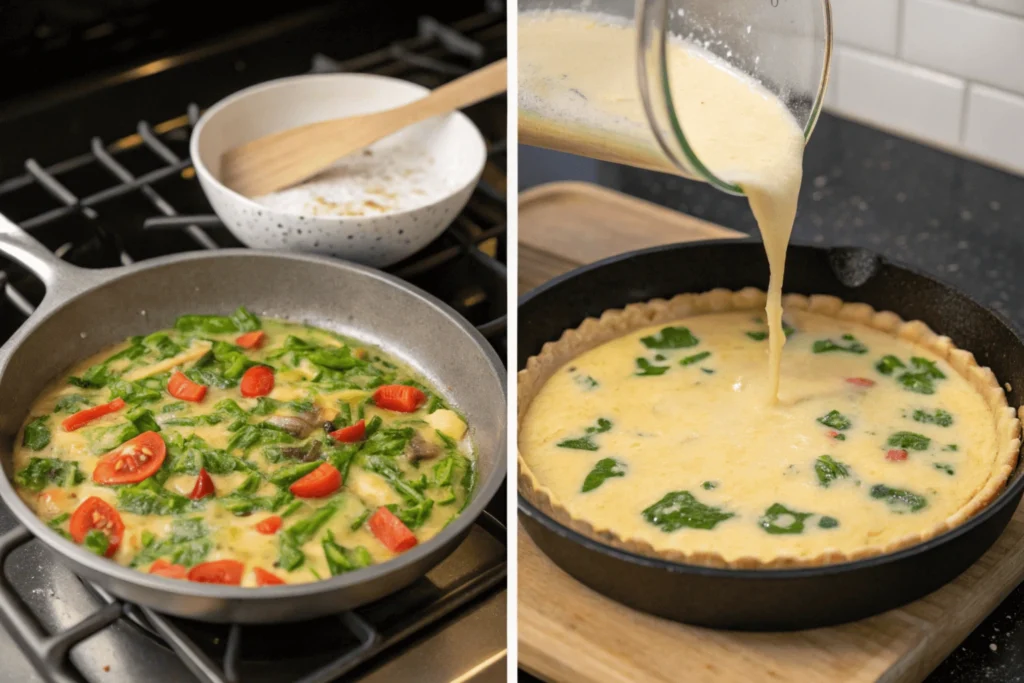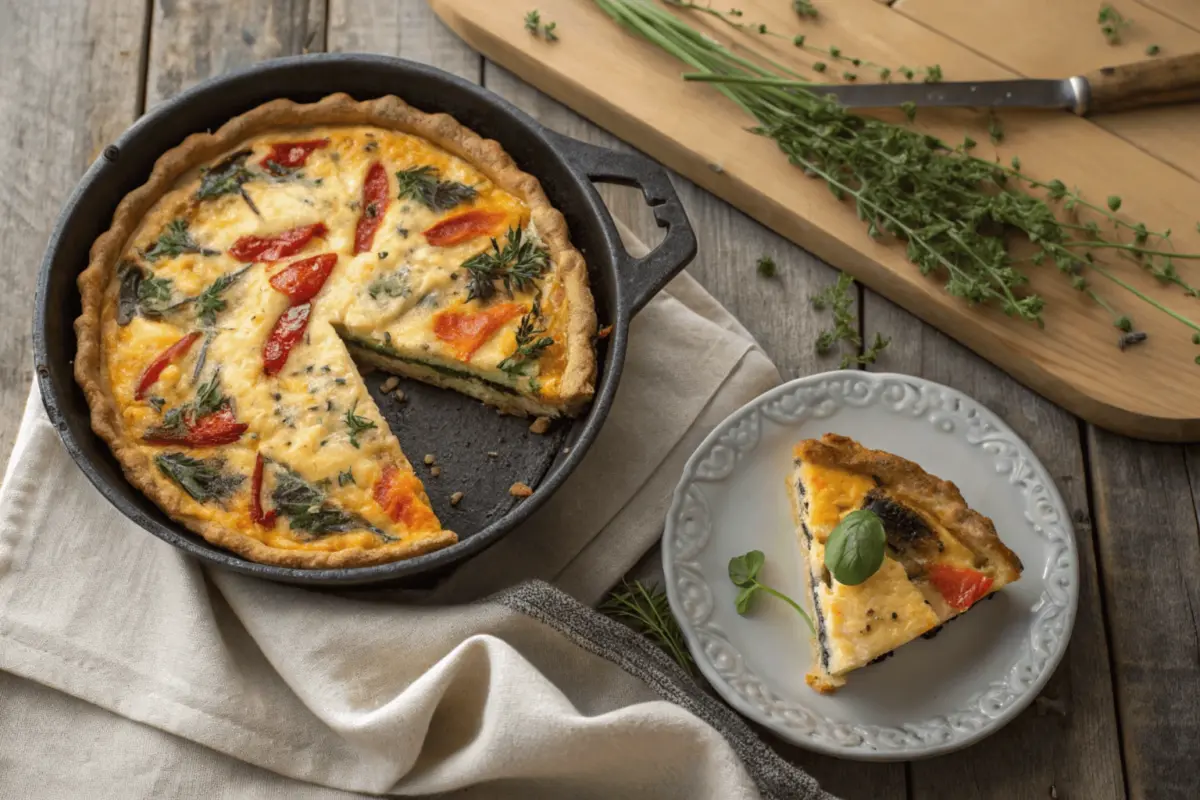Introduction
Have you ever wondered what sets a frittata apart from a quiche? These two egg-based dishes might look similar at first glance, but they’re surprisingly different. From their ingredients to how they’re made, each brings its own flair to the table. Whether you’re a brunch enthusiast or just looking to whip up something delicious, understanding the difference between a frittata and a quiche can help you pick the perfect dish for any occasion. Let’s dive into the details and settle this culinary question once and for all !
Historical Origins of Frittatas and Quiches
The Italian Roots of Frittatas
Frittatas come straight out of Italy, where simplicity and bold flavors reign supreme. Traditionally, they were a clever way to use up leftover vegetables, meats, and cheeses—basically, whatever was hanging out in the fridge. Over time, this humble dish evolved into an egg-based meal that Italians often enjoy for breakfast, lunch, or even dinner.
The French Heritage of Quiches
Quiches, on the other hand, hail from France, with the famous quiche Lorraine originating in the Lorraine region. The richness of smoky bacon and cream encased in a flaky pastry crust makes it a timeless classic. Wondering if you should prebake your quiche crust? Check out Should You Prebake Quiche Crust? for tips on ensuring the perfect texture.
Ingredients Overview
Core Ingredients in Frittatas
Frittatas are all about the eggs. They act as the main ingredient, with veggies, meats, and cheeses mixed in for flavor. There’s no need for heavy cream here—just a splash of milk, if that. It’s a dish that lets fresh, simple ingredients shine.
Essential Ingredients in Quiches
Quiches add heavy cream or half-and-half to eggs, creating their signature custard-like texture. The buttery crust is a defining feature, offering structure and an extra layer of flavor. Want to experiment with a creative base? See how Can I Use Tortillas Instead of Pastry? redefines classic quiche crusts.
Cooking Techniques

How Frittatas Are Prepared
Making a frittata is quick and easy. Start by cooking your fillings in a skillet—think onions, peppers, or sausage. Once everything is nicely cooked, pour beaten eggs over the top, and let the magic happen on the stove. After the edges set, pop it into the oven for a few minutes to finish. No crust, no fuss.
The Baking Process for Quiches
Quiches, though more involved, yield an elegant result. The filling is poured into a pastry crust and baked until perfectly set. For unique takes on this dish, explore a delightful Tortilla Quiche Bake for a modern twist.
The Role of Dairy in Each Dish
Egg-to-Dairy Ratio in Frittatas
Frittatas keep it simple when it comes to dairy. Typically, it’s just eggs with a splash of milk, if any. The focus is on the eggs themselves, so the final texture is firm and satisfying without being overly creamy. This makes it a bit lighter than its French counterpart.
Creamy Texture Achieved in Quiches
Quiches, however, love their dairy. The egg-to-cream ratio is what gives quiches that rich, custard-like texture. Heavy cream or half-and-half is mixed in generously with the eggs, creating a silky smooth filling that melts in your mouth. If indulgence had a texture, this would be it.
Crust vs. Crustless
Frittatas as a Crustless Option
One of the easiest ways to spot a frittata is its lack of crust. Frittatas are all about simplicity, and going crustless keeps the focus on the hearty filling. It’s also a win if you’re avoiding extra carbs or don’t have the time to fuss with dough.
The Importance of a Pastry Crust in Quiches
A quiche without a crust? Not happening. The buttery, flaky pastry is what makes a quiche stand out. It holds everything together while adding a satisfying crunch that contrasts beautifully with the creamy filling. Honestly, the crust is part of the charm.
Texture and Consistency
Fluffy and Firm: Frittata Characteristics
Frittatas have a texture that’s all about balance. They’re firm enough to hold their shape when sliced, but still light and fluffy, thanks to the eggs. It’s like the perfect cross between an omelet and a casserole. You can even eat it cold, and it’s just as good.
Rich and Custardy: Quiche Features
Quiches are on another level when it comes to creaminess. The mixture of eggs and cream bakes into a custard-like consistency that feels luxurious with every bite. Paired with that golden crust, it’s the ultimate combination of soft and crisp textures.
Cooking Time and Complexity
Quick Preparation of Frittatas
Frittatas are made for busy mornings or last-minute dinners. From start to finish, you can whip one up in about 20 to 30 minutes. It’s a one-pan dish, so cleanup is a breeze, too. It’s perfect for when you want something delicious without spending hours in the kitchen.
Detailed Process for Quiches
Quiches, on the other hand, are more of a weekend project. Between making the crust, preparing the filling, and baking everything to perfection, you’re looking at around an hour or more. The payoff is worth it, though. It’s the kind of dish that turns any meal into a special occasion.
Serving and Presentation
Typical Ways to Serve Frittatas
Frittatas are versatile and casual. Serve them straight out of the skillet for a family-style meal, or slice them into wedges for easy serving. They’re great with a simple salad or some crusty bread on the side. They even work as a grab-and-go breakfast.
Traditional Quiche Serving Styles
Quiches are all about elegance. Slice them into neat wedges and serve them on a plate with a garnish of fresh herbs or a dollop of sour cream. They pair wonderfully with a light soup or a crisp green salad, making them ideal for brunches, picnics, or even a fancy lunch.
Popular Variations and Flavor Combinations
Classic Frittata Recipes
When it comes to frittatas, the combinations are endless. You can stick to simple classics like spinach and feta or go bold with sausage, roasted red peppers, and sharp cheddar. Frittatas are also a great way to use leftovers—think last night’s roasted veggies or that half-used block of cheese in the fridge. The best part? It’s almost impossible to go wrong with the flavors you choose.
Favorite Quiche Fillings
Quiches tend to feel a little fancier, which is why their fillings often include decadent ingredients. A traditional quiche Lorraine is always a crowd-pleaser with its mix of smoky bacon and rich Gruyère cheese. For something lighter, you might try a spinach and mushroom filling, or even salmon and dill for a brunch-worthy twist. Whatever you choose, the buttery crust ties it all together perfectly.
Health Considerations
Nutritional Profile of Frittatas
Frittatas are usually the lighter option between the two. They’re high in protein and can be packed with vegetables, making them a nutritious choice. Plus, since they skip the crust, they’re naturally lower in carbs and calories. If you’re looking for a healthy, satisfying meal, a frittata is a fantastic choice.
Calories and Fat Content in Quiches
Quiches, with their creamy filling and buttery crust, are undeniably richer. They tend to have more calories and fat, especially if heavy cream and lots of cheese are involved. However, they’re also incredibly satisfying, so a smaller slice can go a long way. If you’re indulging, quiche is the way to go for a treat-yourself moment.
Regional and Cultural Adaptations
International Takes on Frittatas
Across the globe, variations of frittatas take on local flavors. In Spain, you’ll find the tortilla Española, which is similar but includes potatoes as a key ingredient. Other regions might throw in spices or herbs that reflect their cuisine. No matter where you go, the simplicity of eggs and add-ins makes frittatas easy to adapt.
Global Quiche Interpretations
Quiches, too, have traveled far and wide. You’ll see versions with seafood in coastal areas, while vegetarian options featuring fresh, seasonal produce are popular elsewhere. The French classic remains the gold standard, but it’s fun to see how different regions make it their own with local ingredients.
Pairing Suggestions
Best Side Dishes for Frittatas
Frittatas are so versatile they don’t need much on the side. For breakfast, pair one with toast or fresh fruit. At lunch or dinner, a crisp green salad or roasted potatoes is a perfect match. If you’re feeling fancy, a dollop of sour cream or a sprinkle of fresh herbs can take it up a notch.
Ideal Pairings for Quiches
Quiches shine alongside light and fresh sides. A mixed greens salad with a tangy vinaigrette cuts through the richness beautifully. For something heartier, you can serve quiche with roasted asparagus or even a bowl of creamy soup. And let’s be honest—quiche pairs perfectly with a glass of chilled white wine.
Common Misconceptions
Misunderstood Similarities
People often assume that frittatas and quiches are interchangeable, but that’s not quite true. Yes, they both involve eggs and can feature similar ingredients, but their textures, cooking methods, and overall vibes are totally different. Once you’ve tried both, you’ll definitely notice the distinction.
Myths About Frittatas and Quiches
One common myth is that frittatas are just lazy quiches, but that couldn’t be further from the truth. Each has its own unique preparation and purpose. Another misconception? That quiches are always hard to make. While they do take more time, they’re not nearly as intimidating as they seem.
FAQs
Is a frittata just a crustless quiche?
Not exactly! While a frittata is crustless like you said, it’s much firmer and less creamy than a quiche. The difference really lies in the egg-to-dairy ratio and how each dish is prepared.
What are three main differences between a frittata and a quiche?
First, frittatas are crustless, while quiches have a pastry shell. Second, frittatas use little to no dairy, making them firmer, whereas quiches are creamy from the added cream or milk. Third, frittatas are cooked mostly on the stove, while quiches are fully baked in the oven.
Which is healthier, quiche or frittata?
Generally, frittatas are the healthier choice since they skip the crust and heavy cream. They’re lower in calories and carbs while still being high in protein and veggies.
What makes a frittata so different from an omelet?
A frittata is thicker and designed to serve multiple people, while an omelet is thinner and usually folded over. Plus, frittatas are finished in the oven, giving them a firmer texture compared to the soft, foldable style of an omelet.
Conclusion
Understanding the difference between a frittata and a quiche means you can enjoy each one for what it does best. A frittata is perfect for those moments when you want something quick, hearty, and packed with protein—no crust required. Meanwhile, a quiche is your go-to for indulgent, custardy bites wrapped in a buttery crust that feels a little more refined.
Whether you’re cooking for a weekday breakfast, a casual lunch, or a fancy brunch with friends, there’s no wrong choice here. Both dishes are incredibly versatile and can be customized with your favorite ingredients. So, the next time you’re deciding between a frittata and a quiche, think about the occasion and what kind of vibe you’re going for. Either way, you’re in for something delicious!

